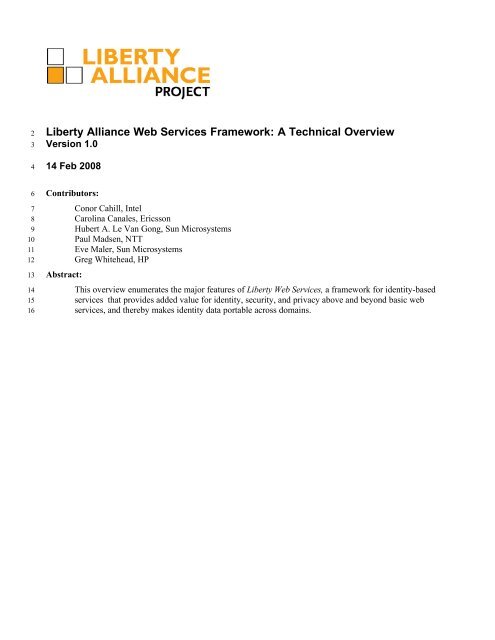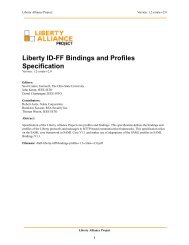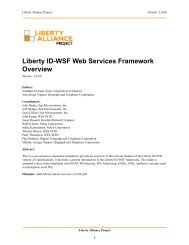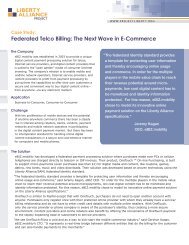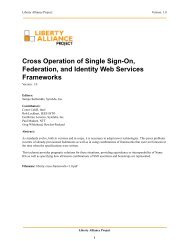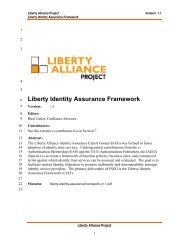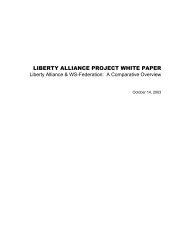Liberty Alliance Web Services Framework: A Technical Overview
Liberty Alliance Web Services Framework: A Technical Overview
Liberty Alliance Web Services Framework: A Technical Overview
Create successful ePaper yourself
Turn your PDF publications into a flip-book with our unique Google optimized e-Paper software.
234<strong>Liberty</strong> <strong>Alliance</strong> <strong>Web</strong> <strong>Services</strong> <strong>Framework</strong>: A <strong>Technical</strong> <strong>Overview</strong>Version 1.014 Feb 2008678910111213141516Contributors:Abstract:Conor Cahill, IntelCarolina Canales, EricssonHubert A. Le Van Gong, Sun MicrosystemsPaul Madsen, NTTEve Maler, Sun MicrosystemsGreg Whitehead, HPThis overview enumerates the major features of <strong>Liberty</strong> <strong>Web</strong> <strong>Services</strong>, a framework for identity-basedservices that provides added value for identity, security, and privacy above and beyond basic webservices, and thereby makes identity data portable across domains.
<strong>Liberty</strong> <strong>Alliance</strong> <strong>Web</strong> <strong>Services</strong> <strong>Framework</strong>: A <strong>Technical</strong> <strong>Overview</strong> Version 1.017181920212223242526272829303132333435ContentsIntroduction.......................................................................................................................................................2Features and Benefits..............................................................................................................................3Terms and Concepts................................................................................................................................5<strong>Liberty</strong> <strong>Web</strong> <strong>Services</strong> Functionality Areas.......................................................................................................7<strong>Web</strong> Service Identity Model...................................................................................................................7Identity Mapping Mechanisms................................................................................................................7Design Patterns for Data Operations.......................................................................................................8Identity Provider <strong>Services</strong>.......................................................................................................................8Social Identity..........................................................................................................................................8Service Discovery....................................................................................................................................9Service Invocation and Message Construction.....................................................................................10Design Pattern for Subscription and Notification.................................................................................10Security Policy.......................................................................................................................................11Privacy...................................................................................................................................................11Bootstrapping.........................................................................................................................................12User Interaction.....................................................................................................................................12Example Use Case and Message Flow...........................................................................................................12Summary.........................................................................................................................................................1436<strong>Liberty</strong> <strong>Alliance</strong> Project2
<strong>Liberty</strong> <strong>Alliance</strong> <strong>Web</strong> <strong>Services</strong> <strong>Framework</strong>: A <strong>Technical</strong> <strong>Overview</strong> Version 1.0373839404142434445464748IntroductionThe term <strong>Liberty</strong> <strong>Web</strong> <strong>Services</strong> comprises the Identity <strong>Web</strong> <strong>Services</strong> <strong>Framework</strong> (ID-WSF) and the IdentityService Interface Specifications (ID-SIS) that take advantage of that framework. Together, these two piecesenable identity-based services – web services associated with the identity attributes of individual users.Why are identity-based services valuable? Fundamentally, because they enable a user's identity data to be portableacross the many <strong>Web</strong> applications that, if able to access these attributes, can provide a more customized &meaningful experience to the user, whilst removing from that user the burden of manually repeatedly providing &managing their identity attributes at each.The following figure shows one scenario where it's useful for a user's calendar data to be accessible to a travelservice at which they are booking a business trip. If able to read both the user's work & personal calendars, thetravel service could suggest a travel schedule that both got them to their first meeting, and subsequently got themhome in time for their daughter's soccer game.Identity-enabling services505152535455565758The travel & calendar services might be run entirely separately, allowing the user to choose service providers onwhatever basis they like and then have them cooperate (with the user's permission) to produce a seamless result.Critically, the calendar data would not be accessible only by the travel service, but also by any other serviceprovider (e.g., the cable provider wanting to set-up an installation appointment) that the user gave permission to.To achieve this flexibility the travel service must be able to find the calendar service in the first place. And thewhole transaction must be secure and must keep disclosure of personal information to a minimum.The travel service and the calendar service both need to convey, and be responsive to, the user's identityinformation and the parameters the user had set for its use. To interact with each other they use web servicestechnology, some of it generic to all types of web services and some of it specially standardized by <strong>Liberty</strong> <strong>Web</strong><strong>Liberty</strong> <strong>Alliance</strong> Project3
<strong>Liberty</strong> <strong>Alliance</strong> <strong>Web</strong> <strong>Services</strong> <strong>Framework</strong>: A <strong>Technical</strong> <strong>Overview</strong> Version 1.05960616263646566676869<strong>Services</strong> to handle the identity dimension and its security and privacy requirements. ID-WSF builds on manyexisting standards for networking and distributed computing, and adds specialized capabilities for handlingidentity-related information and tasks and for ensuring privacy and security.With ID-WSF providing the addressing, security & privacy plumbing – different ID-SIS specifications define thespecific syntax and semantics for sharing different slices of your identity attributes. For instance, a Calendar SISspecifies how the travel service would query the user's Calendar Service for free blocks, or write an event. OtherID-SIS specification either already exist or can be defined for other aspects of your identity, e.g., The user'spersonal profile, geolocation, presence, or wallet.Features and BenefitsThe following diagram shows the <strong>Liberty</strong> <strong>Web</strong> <strong>Services</strong> architecture at a high level.High-level view of the <strong>Liberty</strong> <strong>Web</strong> <strong>Services</strong> architecture717273747576777879808182838485This paper will focus primarily on the framework features provided by ID-WSF for identity-based web services.An identity-based service is one that exposes an interface on behalf on a particular user's identity – so in ourscenario, the calendar service is identity-based because it is your calendar service and not applicable to everyone.The ID-WSF specifications standardize common functionality that developers can use in incorporating identitybasedapplication features, including:Authentication – The provider of a service, such as the calendar service, might need to know who isrequesting services in order to control access or provide personalized features. Thus, service requesterstypically need to be authenticated, and messages sent between the parties need to be verified as comingfrom the claimed senders. Authentication depends on the notion of identity: Who is accessing my service,and who is this message from?Message protection – All web service endpoints, including both the providers of identity-based servicesand the services that use them in turn, need to know that messages they send cannot be intercepted by amalicious entity and then either modified or cached and then replayed.Privacy protection – Unless special care is taken, identifiers used to label you in web service calls canallow your actions and true identity to be inappropriately correlated and exposed.<strong>Liberty</strong> <strong>Alliance</strong> Project4
<strong>Liberty</strong> <strong>Alliance</strong> <strong>Web</strong> <strong>Services</strong> <strong>Framework</strong>: A <strong>Technical</strong> <strong>Overview</strong> Version 1.0128129130131132133134135136137138139140141142143144145146147148149150151<strong>Services</strong>Discovery Service (DS) – A special web service that allows WSCs to find a relevant WSP associatedwith a particular user identity. This involves web service registration as a first step. Normally, as wellas facilitating the WSCs to discover where on the network the user's different identity attributes arelocated, the DS enables the WSC to actually send a request for identity to that WSP endpoint byissuing to the WSC an identity token to be included in the request.Identity Mapping Service (IMS) – A special web service for mapping user identifiers betweendifferent provider namespaces. Identity mapping may be required when providers use pairwisepseudonyms to refer to users, a technique often used for its privacy advantages.Interaction Service (IS) – A special web service that facilitates communication between a providerand a user in order to obtain privacy consent or identity attributes. You might set up interaction rulesfor having your calendar service contact you by SMS in order to gather your consent for calendareditingby others.People Service (PS) – A special web service that helps a user manage and reuse the person-to-personfederations that reflect the user's social network. You might use the People Service to set up groupsof, and roles for, your friends' identities to help manage the online planning for an upcoming party,regardless of whatever IdP each friend uses.Authentication Service (AS) – A special web service that that supports those clients or user-agentswith special abilities (beyond a normal browser) for actively participating in <strong>Liberty</strong> <strong>Web</strong> Servicemessaging. The AS allows such <strong>Liberty</strong>-enabled clients to authenticate to an IdP in order to obtainidentity tokens for use in web service calls to WSPs.Single Sign On Service (SSOS) – A web service that supports <strong>Liberty</strong>-enabled clients to achieveSSO with an SP as if it were a plain browser.152153154155156157158159160161162163164165166<strong>Liberty</strong> <strong>Web</strong> <strong>Services</strong> Functionality AreasThe following sections examine each functionality area in which <strong>Liberty</strong> ID-WSF provides unique identity,privacy, and security value, and suggest sources for further reading.<strong>Web</strong> Service Identity ModelA model is required for carrying the identity of the various parties associated with a transaction within themessages generated to invoke a web service. The parties potentially needing to be identified include:Sender – The party sending the message.Recipient – The party to whom the message is sent.Invoker – The party invoking the request. This can be the same as the sender, or it may be different (suchas when an entity is invoking a service on behalf of a user).Target Identity – The party whose resource is being accessed by the recipient. This may be the invoker'sresource, or a third party's resource, or the recipient's resource. For example, when you query your ownmail from an email provider, it is the invoker's (your) resource being accessed. When you query thecalendar of a colleague from a calendar provider, it is your colleague's resource being accessed.Each of these parties should have a known method for identification on each request and the request should permit<strong>Liberty</strong> <strong>Alliance</strong> Project7
<strong>Liberty</strong> <strong>Alliance</strong> <strong>Web</strong> <strong>Services</strong> <strong>Framework</strong>: A <strong>Technical</strong> <strong>Overview</strong> Version 1.0Service discovery prior to invocation265266267268269270271272273274275276277278279280281282283284285286287288289Service Invocation and Message ConstructionSOAP provides the definition of the XML-based information that can be used for exchanging structured andtyped information between peers in a decentralized, distributed environment. SOAP is silent on the semantics ofany application-specific data it conveys, as it is on issues such as the routing of SOAP messages, reliable datatransfer, firewall traversal, and so on. However, SOAP provides the framework by which application-specificinformation may be conveyed in an extensible manner (the property known as “SOAP Extensibility”).ID-WSF V2.0 adds an identity, security, and privacy layer around the application-specific data found in messages.It allows for mapping onto various transport or transfer protocols, SOAP being the typically chosen one. Thisimplies that messages addressed to any <strong>Liberty</strong> infrastructural service or to any other identity-enabled service thatmakes use of ID-WSF will be typically conveyed in the body of a SOAP message.ID-WSF V2.0 defines the following components in support:Mechanisms based on <strong>Web</strong> <strong>Services</strong> Addressing 1.0 – Core and <strong>Web</strong> <strong>Services</strong> Addressing 1.0 - SOAPBinding to provide transport-neutral mechanisms to address an identity-based web service, as defined inthe SOAP Binding specification (Section 5).SOAP headers together with processing rules needed for the invocation of identity-based web services.The features provided by these headers could be classified as follows:1. Privacy-related (Consent, Usage Directives): Used by the requester in order to indicate the privacycontext in which the service invocation takes place, or the subsequent use and distribution of theobtained invocation. These features are defined in Section 6.2. Processing or security context (Processing Context, Credential Context, Endpoint Update, Timeout,Application EPR, and Sender): Used by the parties to transfer extra information needed for thecommunication to take place (including token renewal or redirection to a different endpoint). Thesefeatures are defined in Section 6.3. User interaction: ability to interact with the user.4. Identity-related information (Target Identity).<strong>Liberty</strong> <strong>Alliance</strong> Project11
<strong>Liberty</strong> <strong>Alliance</strong> <strong>Web</strong> <strong>Services</strong> <strong>Framework</strong>: A <strong>Technical</strong> <strong>Overview</strong> Version 1.0371372373374375376377378379380381382383384385386387388389390391392393394395396397398399User InteractionUser interaction mechanisms are systems (such as messages and prompts) by which providers engaged in anidentity transaction concerning particular users can reach out and contact those users if they are not currentlyactively visiting that provider.Such an interaction may be necessary in order to, for instance, obtain consent for the release of some piece of thatuser's identity information or to collect a piece of identity information requested by another provider.ID-WSF V2.0 defines the following components in support:A SOAP Header block that allows a WSC to indicate its preferences and capabilities for interactions withrequesting users, and possibly a service endpoint to which interaction requests can be sent, as defined inthe SOAP Binding specification (Section 6.8).A SOAP fault and redirect request protocol by which the WSP can request that the user agent be directedto a particular address for interaction, as defined in the SOAP Binding specification (Section 7).A SOAP service to which providers can send messages requesting that the user be interacted with, asdefined in the Interaction Service specification (Section 3).Example Use Case and Message FlowThis section examines a complete scenario – describing the full set of messages that flow between the varioussystem entities to achieve an identity- and privacy-enabled result.In this use case, a Travel Service provider MyTrips.com, after allowing a user to single sign-on from an IdentityProvider MyIdee.com, locates and queries information about the user from a web service that holds the user'scalendar information. The calendar service MyCalendar.com is, in turn, able to locate and utilize an interactivemeans of contacting the user in order to obtain the user's approval to release the requested calendar information.The message flow for this use case involves bootstrapping from the user's single sign-on interaction (Step's 1, 2,& 3) into the identity services world (other Steps) – using the bootstrap mechanism in order to locate and gainaccess to the Discovery Service, and then using the Discovery Service to locate and gain access to MyCalendarand the Interaction Service in turn.Note that user interaction is typically not required on a per-request basis, as the necessary approvals may beremembered from previous interactions, and/or the user's privacy policies may be managed out of band. Also,note that the role of a dynamic Discovery Service is key for providing the “nested” ability of one identity serviceto locate and access another.<strong>Liberty</strong> <strong>Alliance</strong> Project14
<strong>Liberty</strong> <strong>Alliance</strong> <strong>Web</strong> <strong>Services</strong> <strong>Framework</strong>: A <strong>Technical</strong> <strong>Overview</strong> Version 1.04014024034044054064074084094104114124134144154164174184194204211. The user SSOs into MyTrips.com from MyIdee.com, resulting in a SAML2 assertion being sent toMyTrips.com, that includes the bootstrap ID-WSF endpoint reference (EPR) for the user's DiscoveryService (DS).An ID-WSF EPR extends a basic WS-Addressing EPR to allow inline specification of endpoint securitypolicy and inclusion of required security and identity tokens. In this flow, it is assumed that the bootstrapDS EPR includes any needed security and identity tokens (perhaps referring to the enveloping <strong>Web</strong> SSOtoken).Note that if the user had authenticated directly to the MyTrips.com SP, it would have had to find anothermeans of locating the DS.2. MyTrips.com needs user identity information, and so calls the DS to discover the user's Calendar Service(which in this case is MyCalendar.com)3. The DS responds with an ID-WSF EPR for MyCalendar.com.Again, in this flow, it is assumed that the MyCalendar.com EPR specifies the endpoint security policy andincludes any needed security and identity tokens. The security token could be, for example, a SAMLtoken with the user as the subject identity and MyTrips.com as the subject confirmation identity. Thistoken could also include a bootstrap Discovery Service EPR, which MyCalendar.com could use to invokeother services.4. MyTrips.com asks MyCalendar.com for the user's open calendar slots around the desired time of travel.5. MyCalendar.com determines that it needs consent from the user before releasing the event information,and so discovers the user's Interaction Service (IS).<strong>Liberty</strong> <strong>Alliance</strong> Project15
<strong>Liberty</strong> <strong>Alliance</strong> <strong>Web</strong> <strong>Services</strong> <strong>Framework</strong>: A <strong>Technical</strong> <strong>Overview</strong> Version 1.0422423424425426427428429430431432433434435436437438439440441442443444445446447Note that this step assumes that the bootstrap DS EPR was included in the security token presented toMyCalendar.com or was cached and already available to it, and that the user has an IS. An alternative isto return a SOAP Fault indicating that the user needs to be redirected to the CS to provide consent.6. The DS responds with an ID-WSF EPR for the IS.Again, in this flow, it is assumed that the IS EPR specifies the endpoint security policy and includes anyneeded security and identity tokens. The security token could be, for example, a SAML token with theuser as the subject identity and the CS as the subject confirmation identity.7. MyCalendar.com invokes the IS in order to secure consent from the user so that MyTrips can receive therequested information.8. The IS sends an SMS to the user's cell phone (an interaction that is out-of-band with respect to <strong>Liberty</strong><strong>Web</strong> <strong>Services</strong>; any other communications channel could be used instead).9. The user responds with a confirmation (again, an interaction that is out-of-band with respect to <strong>Liberty</strong><strong>Web</strong> <strong>Services</strong>).10. The IS responds to MyCalendar.com in the affirmative.11. Confident that the user has given their release, MyCalendar.com responds to MyTrips with the requestedcalendar information.SummaryAn identity-based service is a web service associated with a particular user, i.e., a web service at which a user'scalendar information can be accessed. Identity-based services require functionality beyond that necessary forbasic web services not associated with a given user – particularly in the areas of identity, security, and privacyThis paper has outlined how <strong>Liberty</strong> <strong>Web</strong> <strong>Services</strong> framework meets these functional requirements.<strong>Liberty</strong> ID-WSF specifications define the addressing, security & privacy plumbing – and different <strong>Liberty</strong> ID-SISspecifications define the specific syntax and semantics for sharing different slices of identity attributes. Together,ID-WSF & ID-SIS make identity data portable in a secure & privacy-respecting manner.<strong>Liberty</strong> <strong>Alliance</strong> Project16


